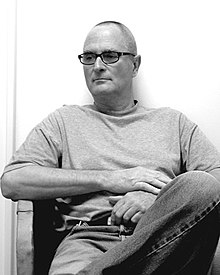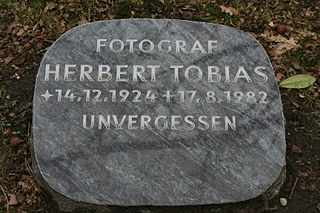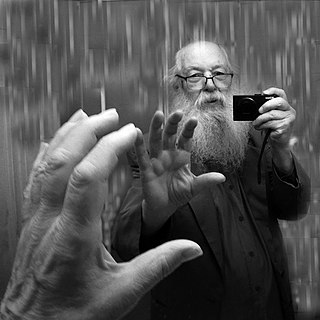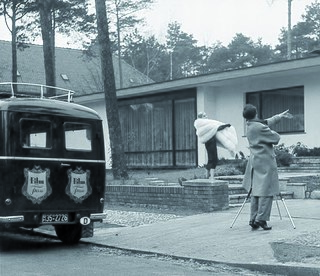
Christian von Alvensleben (born 1941) is a German photographer.

Christian von Alvensleben (born 1941) is a German photographer.
Christian von Alvensleben was born in Munich, and took his first photos with a Kodak box camera from a US care parcel when he was 11. These were followed by photos for the school newspaper. As an 18-year-old schoolboy he travelled to France in order to improve his language skills in preparation for his school-leaving examinations. In Montjustin in Provence he met the young German author Hubert Fichte. The photos taken on that one day were exhibited in the Deichtorhallen in Hamburg in 2005 and are now part of the Hubert-Fichte Foundation. [1]
In 1962 he travelled to Mozambique where he took photographs of big game and the respective hunters. The work titled Die Spur des Leoparden / Kaliber .378 was shown at the photokina exhibition in 1993.[ citation needed ]. [2] He attended the London Polytechnic from 1964 onwards. After this he became assistant to the photographer Karl-Heinz von Ludwig/Ali Khan in Munich. Since 1968 he has been working as a freelance photographer with his own studio in Hamburg. The pictures for the social democrat party's print media advertisements for the election campaign were among his first major works. His photograph Der Sonnenschein of a nude lady with a full figure and a sunshade on the beach for an advertisement for the film manufacturer Fujifilm became world famous in 1972; Time magazine devoted a whole page to the photo, [3] and today the motif is one of the Bilder im Kopf (Images in the mind's eye) (Deutsches Presse-Museum, Deutsches Zeitungsmuseum). [4]
This was followed by international editorials and advertising productions in architecture, interior design, fashion, beauty, food, people, still-life and transportation.
Christian von Alvensleben portrays industrial managers, actors, sportsmen and women, musicians, politicians, fashion designers and TV stars. [5] In addition to numerous photo illustrations for the books of chefs and bon vivants such as Alfons Schuhbeck, Alfred Biolek, Christiane Herzog, Bruno Bruni and 'Food in Vogue' [5] / Condé Nast, Christian von Alvensleben created a work in 1992 entitled the 'Apocalyptic Menu' for which he received several renowned prizes. [6] Many of his almost always avant-garde works appear in magazines including Architektur & Wohnen, Dance Magazine , Der Feinschmecker, FAZ , GEO , Max , Merian , Der Spiegel , Stern , Vanity Fair US, Vogue Braut, Vogue Casa, Vogue Deutsch, Vogue Pelle, and Die Zeit . [5]
The editorial team of Der Feinschmecker nominated Christian von Alvensleben as a 'Hall of Fame Member' in commemoration of its 30th anniversary; [7] Designers Digest awarded him the title '(Photo) Designer of the Year' in 2002 [8] and 'novum' reports [9] that Christian von Alvensleben is one of the most constant dimensions in German photo design and one of the most universal. In 2005 a work already awarded a prize by the Art Directors Club (ADC) was nominated for the 2006 Designpreis der Bundesrepublik Deutschland . In over 35 years of photographic work, the ADC alone has given over 80 awards [10] to Christian von Alvensleben for individual works, including several gold medals and even the Grand Prix in 1993, something very unusual for a photographer. [11] In 2009 the ADC gave him a Lifetime Achievement award. [12] His competence is often highly esteemed in juries. [13] Since 2006 Christian von Alvensleben has been working exclusively on his own photography projects.
Reinhart Wolf Stiftung council since 1994.

Max Bill was a Swiss architect, artist, painter, typeface designer, industrial designer and graphic designer.
Oscar Leopold von Gebhardt was a German Lutheran theologian, born in the Baltic German settlement of Wesenberg in the Russian Empire.

Herbert Tobias was a German photographer who first became well known for his fashion photography during the 1950s. His portrait studies, his photographs of Russia during World War II and his homoerotic pictures of men are all of artistic value. He was one of the first well-known people in Germany to die from AIDS.

Hubert Fichte was a German novelist.
The Deutsche Fotothek is a picture library in Dresden, Germany, located in the Saxon State Library. It holds more than two million images. Its strengths are in art, architecture, music, geography, technology, the economy, and the Saxony region. Its collection came from institutions, companies, and individuals such as Hermann Krone.
The Konrad Adenauer Prize was an award by the Germany Foundation, a national conservative organisation associated with the Christian Democratic Union, from 1967 to 2001 It was given annually between 1973 and 1975, then every two years, with exceptions, from 1975 to 2001. It was given to right-wing intellectuals and was named in memory of statesman and former German Chancellor Konrad Adenauer. The journalism and literary prizes are now both separate prizes altogether.

Thomas Tadeus Bak is a German visual artist, art director, writer and composer, mainly known for his work in photography.

The Deutscher Pfadfinderbund (DPB) (literal translation German Scouting Union) was the first German Scouting association, and the forerunner of the Deutscher Pfadfinderbund (1945). It existed from 1911 until 1933, when it was disbanded by the National Socialists.
Heinrich August Vater was a German soil scientist and forestry scientist. Vater was a pioneer in the areas of forest soil science, land evaluation, and forest fertilization.

Arno Fischer was a German photographer and university teacher.

Alex Kempkens is a German photographer, photojournalist and computer artist. He also writes articles and curates exhibitions. Kempkens is an autodidact.

Edmund Collein was an East German architect and urban planner. He is also known for his photography while studying at the Bauhaus art school.

Manfred Rieker is a German photographer and photo designer He works in the advertising field for national and international corporate clients and individuals in the automobile, furniture and show business industry.
Franz Herre is a German biographer, historian and journalist.

Ole Wittmann is a German art historian, curator and publisher. He is specialized in the role of tattooing in art. His research on the German tattoo history of the late 19th and 20th century is considered pioneering. He has written the first German doctoral thesis on tattooing and art and his research has generated considerable media interest.

Franz Christian Gundlach was a German photographer, gallery owner, collector, curator and founder.

Harry Weibel is a German historian. His main topics are neo-Nazism, right-wing extremism and antisemitism in the GDR and racism in Germany from 1945 to the present.
Stefan Moses was a German photographer living in Munich.
Andreas Müller-Pohle is a German photographer, media artist and publisher. He is considered an important representative of experimental photography and is the originator of the theory of "Visualism".

Fritz Peyer was a German theatre photographer and photojournalist specialising in opera, ballet and equestrian sport.